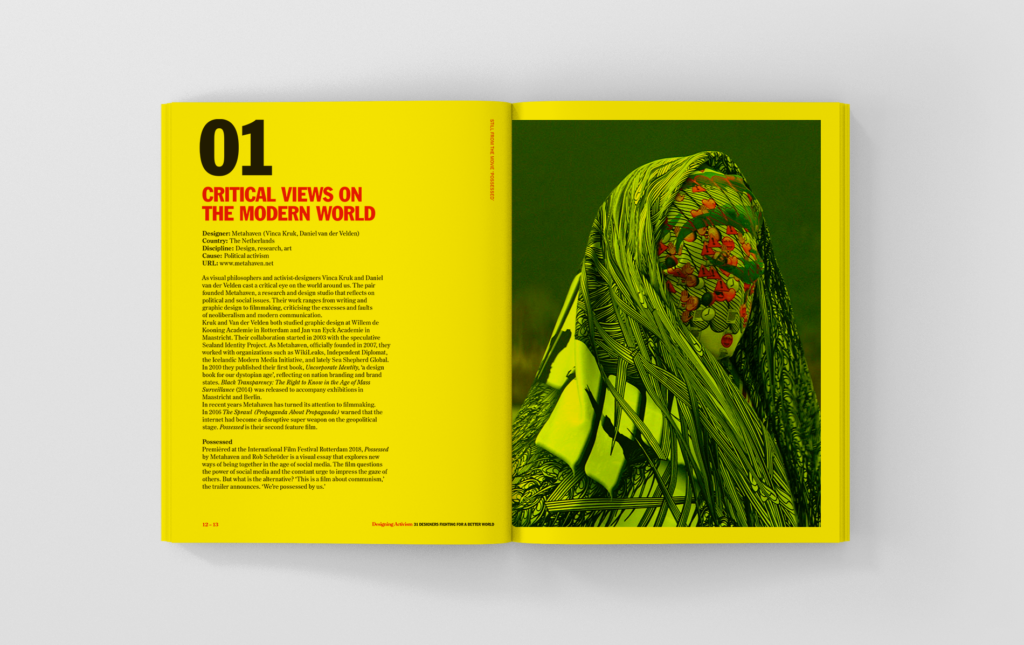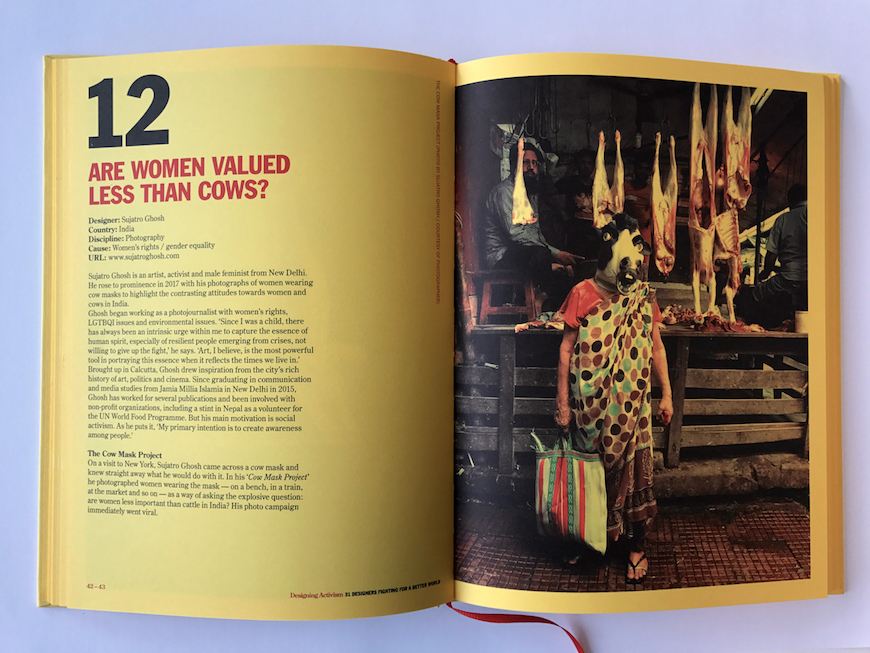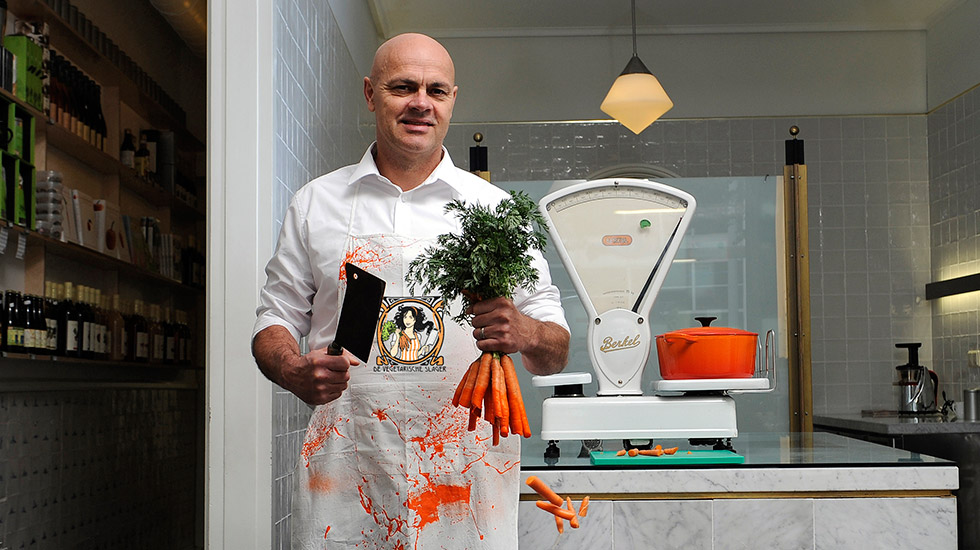As a designer, you must be aware that every decision you make has an impact on society. So, design is something that influences our lives more than we can imagine. It also means, that as designer you have a great responsibility to contribute to a better world with your creative work. It is a responsibility to take your creative work as a tool to draw attention to socially relevant issues that others may close their eyes to.
For this blog entry, I would like to introduce some famous design activists, which are shown in the book “Designing Activism – 31 Designers Fighting for a Better World” (2018). The book was created from the platform “What Design Can Do”, which promotes the use of design as a tool to achieve the UN’s Sustainable Development Goals.
Designers and their projects, which are shown in the book, highlight various topics such as social, political and economic issues as well as environmental change.
01: CRITICAL VIEWS ON THE MODERN WORLD

Country: The Netherlands
Discipline: Design, research, art
Cause: Political activism
The designers Vinca Kruk and Daniel van der Velden founded the research and design studio Metahaven, where they are reflecting on political and social issues. They are doing writing, graphic design and also filmmaking, focusing on criticizing the excesses and faults of neoliberalism and modern communication. They already worked with organizations such as WikiLeaks, Independent Diplomat, the Icelandic Modern Media Initiative and Sea Shepherd Global.
In recent years, the two designers are focusing more and more on filmmaking. In 2016, their film “The Sprawl (Propaganda About Propaganda)” dealt with a warning that the internet had become a disruptive super weapon on the geopolitical stage and thus also a sovereignty that knows no norm. It examines the significance and power of propaganda in the age of social media. The film examines the war in Ukraine and sifts through misinformation and media claims about who is responsible for the shot down of Amsterdam flight MH17 in 2014. It leads through the heated battles between Russia’s English-language channel Russia Today and the US news channel CNN. The film also poses the question of how we can trace and understand truth in a digitally networked world. Anyone with access to a smartphone is able to document events and disseminate information, while automated bots are increasingly used to control public opinion.
“The effect, the spin of the information is much more important than the factual content,” says Daniel van der Velden.
The problem is: Who has the power of interpretation?
Their second film “Possessed” shows ways of being together in the age of social media. It points at the power of social media and the constant urge to impress the gaze of others. A film about togetherness in the age of the smartphone. While 20th century state communism was supposed to lead to a better and improved society, a new and personal communism now arises in the cracks and voids of the system. Possessed is a film that swings between documentary and dream landscape to denounce a smartphone-heavy world. In the film a representative of Generation Y discovers a forgotten past and searches for new ways of empathy.
02 ARE WOMAN VALUED LESS THAN COWS?

Country: India
Discipline: Photography
Cause: Women’s rights/ gender equality
‘Are women valued less than cows?’ shows women from India, wearing a cow mask in daily situations, such as sitting on a bench, sitting in a train, being at the market and so on.
The photo campaign from the artist, activist and male feminist Sujatro Gosh from New Delhi want to put attention on the question, if women are less important than cows in India. He highlights the contrasting attitudes towards women and cows in his home country.
He got the idea for this project on a visit to New York, where he came across a cow mask. Straight away he knew what he would do with it.
In India, 36,735 women were raped only in 2014. Ghosh believes gender-based violence needs to be made visible to begin its eradication.The cow is venerated as a sacred animal with penalties ranging from 3 years in prison to life sentence for murder of the animal. While the most conservative groups protect the cow as a sacred animal, they look away to gang-rape or femicides.
It is a great project, which was created on the basis of a spontaneous idea of the artist. For me, it is an example, that shows the power behind social and political structures. With his Photography, Sujatro Gosh points attention on the existing situations in India, but he also shows that every individual in a society is affected by the cultural and political structures of power, which dominates the respective society. What I find particularly interesting is the fact that the artist found the idea for this artwork during a walk through New York when he saw this cow mask. His immediate association was the conditions in his home country and the inequalities that the women there experience. An example, as already mentioned at the beginning, that we often don’t realize how design influences us in every area of our life.
03 EAT MEAT WITHOUT KILLING ANIMALS

Country: Netherlands
Discipline: Food
Cause: Meat without animals
Jaap Korteweg took over the family farm in ninth generation, where he witnessed major outbreaks of mad cow disease and swine fever in the 1990s. His cold stores served as a temporary storehouse for thousands of cadavers, what led him to change his outlook. After a few years in 1997, he changed his arable farming to organic farming and tried to become a vegetarian himself. But he missed the taste of meat and also realized that more and more diets added meat, which causes a bad impact on the environment and the climate.
For Korteweg a double-motivation to search over ten years for innovative meat substitutes with a spectacular bite and texture. His extensive research with help of master chefs led to the foundation of his company The Vegetarian Butcher. The company has broad range of products, an honest story and a clear design. They fill seven million packages of vegetarian meatballs, chicken and sausages every year, have an annual turnover of twenty million euros and export their products to fifteen countries.
Especially in times of climate change, people like Jaap Korteweg are so important for all of us. He grew up on a farm and was used to the taste of meat from childhood on, nevertheless he searched for ways to live without meat. He invested a whole decade to find this way and also affects a lot of other people with it. In my eyes he can be seen as pioneer, he made it towards his ultimate aim: becoming the biggest butcher in the world.
Sources:
https://www.hkw.de/de/programm/projekte/veranstaltung/p_129787.php
https://www.itsnicethat.com/features/metahaven-thesprawl-110216
https://cineuropa.org/en/video/rdid/344836/
https://www.moviepilot.de/movies/possessed–3
https://genevievecostello.net/portfolio/possessed
https://www.thevegetarianbutcher.com